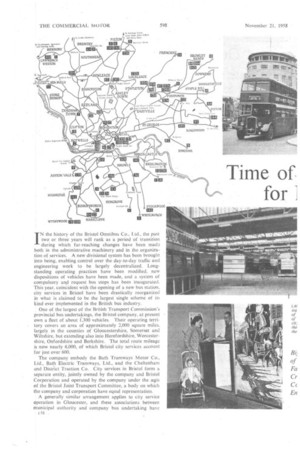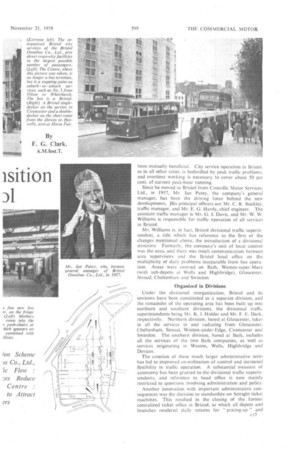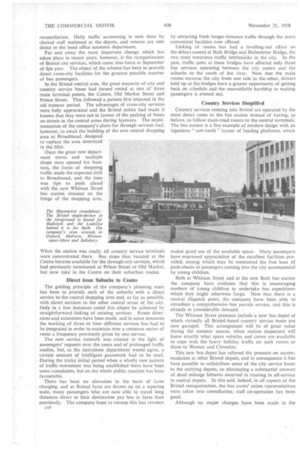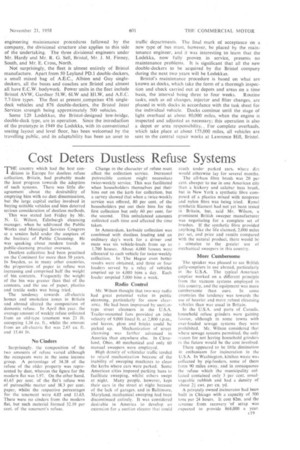Time of for
Page 54

Page 55

Page 56

Page 57

If you've noticed an error in this article please click here to report it so we can fix it.
isition 31
IN the history of the Bristol Omnibus Co., Ltd., the past two or three years will rank as a period of transition during which far-reaching changes have been math both in the administrative machinery and in the organization of services. A new divisional system has been brought into being, enabling control over the day-to-day traffic and engineering work to be largely decentralized. Longstanding operating practices have been modified, new dispositions of vehicles have been made, and a system of compulsory and request bus stops has been inaugurated. This year, coincident with the opening of a new bus station. city services in Bristol have been drastically reorganized in what is claimed to be the largest single scheme of its kind ever implemented in the British bus industry.
, One of the largest of the British Transport Commission's provincial bus undertakings, the Bristol company, at present own a fleet of about 1.,300 vehicles. Their operating territory covers an area of approximately 2,000 square miles, largely in the counties of Gloucestershire, Somerset and Wiltshire, but extending also into Herefordshire, Worcestershire, Oxfordshire and Berkshire. The total route mileage is now nearly 6,000, of which Bristol city services account for just over 600.
The company embody the Bath Tramways Motor Co., Ltd., Bath Electric Tramways, Ltd., and the Cheltenham and District Traction Co. City services in Bristol form a separate entity, jointly owned by the company and Bristol Corporation and operated by the company under the aegis of the Bristol Joint Transport Committee, a body on which the company and corporation have equal representation.
A generally similar arrangement applies to city service operation in Gloucester, and these associations between municipal authority and company bus undertaking have cI6 been mutually beneficial. City service operation in Bristol, as in all other cities, is bedevilled by peak traffic problems, and overtime working is necessary to cover about 50 per cent. of current peak-hour running.
Since he moved to Bristol from Crosville Motor Services. Ltd., in 1957, Mr. Ian Patey, the company's general manager, has been the driving force behind the new developments, j-lis principal officers are Mr, C. R. Buckley, traffic manager, and Mr. E. G. Hardy, chief engineer. The assistant traffic manager is Mr. G. 1. Davis, and Mr. W. W. Williams is responsible for traffic operation of all services in Bristol.
Mr. Williams is, in fact, Bristol divisional traffic superintendent, a title which has reference to the first of the changes mentioned above, the introduction of a divisional structure. Formerly, the company's unit of local control was the area, and there was much communication between area supervisors and the Bristol head office on the multiplicity of daily problems inseparable from bus operation. Areas were centred on Bath, Weston-super-Mare (with sub-depots at Wells and Highbridge), Gloucester. Stroud, Cheltenham and Swindon.
Organized in Divisions Under the divisional reorganization, Bristol and its environs have been constituted as a separate division, and
wer,hon the remainder of the operating area has been built up into northern and southern divisions, the divisional traffic superintendents being Mr. K. I. Holder and Mr. F. E. Dark, respectively, Northern division, based at Gloucester, takes in all the services in and radiating from Gloucester. Cheltenham, Stroud, Wotton-under-Edge, Cirencester and Swindon. The southern division, based at Bath, includes all the services of the two Bath companies, as well as services originating in Weston, Wells, Highbridge and Devizes.
The creation of these much larger administrative units has led to improved co-ordination of control and increased flexibility in traffic operation. A substantial measure of autonomy has been granted to the divisional traffic superintendents, ,and reference to head office is now mainly restricted to questions involving administration and policy.
Another innovation with important administrative consequences was the decision to standardize on Setright ticket machines. This resulted in the closing of the -former centralized ticket office in Bristol, to which all depots and branches rendered daily returns for " pricing-up " and reconciliation. Daily traffic accounting is now done by clerical staff stationed at the depots, and returns are sent direct to the head Office accounts department.
Far and away the most important change which has taken place in recent years, however, is the reorganization of Bristol city services, which came into force in September of this year. The object of the scheme has been to provide direct cross-city facilities for the greatest possible number of bus passengers.
In the Bristol central area, the great majority of city and country service buses had turned round at one of three main terminal points, the Centre, Old Market Street and Prince Street. This followed a pattern first imposed in the old tramcar period. The advantages of cross-city services were fully appreciated and the Bristol police had made it known that they were not in favour of the parking of buses on streets in the central areas during layovers. The implementation of the company's plans for through services had, however, to await the building of the new central shopping area at Broadmead, designed to replace the area destroyed in the blitz.
Once the great new department stores and multiple shops were opened for business, the focus of shopping traffic made the expected shift to Broadmead,and the time was ripe to push ahead with the new Whitson Street bus station situated on the fringe of the shopping area.
The Haymarket roundabout : The Bristol single-decker in the foreground is bound for Radstoek and the Lodekka behind it is for Bath. The company's area extends to Oxford, Malvern, Weston super-Mare and Salisbury.
When the station was ready, all country service terminals were concentrated there. Bus stops thus vacated at the Centre became available for the through-city services, which had previously terminated at Prince Street or Old Market, but now take in the Centre on their suburban routes.
Direct from Suburbs to Centre
The guiding principle of the company's planning team has been to provide each of the suburbs with a direct service to the central shopping area and, as far as possible, with direct services to the other central areas of the city. Only in a few instances could this object be achieved by straightforward linking of existing services. Route diversions and extensions have been made, and in some instances the working of three or four different services has had to be integrated in order to maintain over a common sector of route a frequency previously given by one service.
The new service netwofk was created in the light of passengers' requests over the years and of prolonged traffic studies, but, as the operations department would agree, a certain amount of intelligent guesswork had to be used. During the tricky initial period when a wholly new pattern of traffic movement was being established there have been some complaints, but on the whole public reaction has been favourable.
There has been no alteration in the basis of fares charging, and as Bristol fares are drawn up on a tapering scale, many passengers who are now able to travel long distances direct to their destination pay less in fares than previously. The company hope to recoup this lost revenue c18 by attracting fresh longer-distance traffic through the more convenient facilities now offered.
Linking of routes has had a levelling-out effect on the delays caused at Bath Bridge and Bedminster Bridge, the two most notorious traffic bottlenecks in the city. In the past, traffic jams at these bridges have affected only those bus services operating between the city centre and the suburbs to the south of the river. Now that the main routes traverse the city from one side to the other, drivers held up at the bridges have a greater opportunity of getting back on schedule and the unavoidable hardship to waiting passengers is evened out.
Country Services Simplified
Country services running into Bristol are operated by the most direct route to the bus station instead of having, as before, to follow main-road routes to the central terminals. The bus station is a fine example of modern design with an ingenious " saw-tooth " layout of loading platforms which makes good use of the available space. Many passengers have expressed appreciation of the excellent facilities provided, among which may be mentioned the free loan of push-chairs to passengers coming into the city accompanied by young children.
Both at Whitson Street and at the new Bath bus station the company have evidence that this is encouraging mothers of young children to undertake bus expeditions which they might otherwise forgo. Now that there is a central dispatch point, the company have been able to introduce a comprehensive bus parcels service, and this is already in considerable demand.
The Whitson Street premises include a new bus depot at which virtually all Bristol-based country service buses are now garaged. This arrangement will be of great value during the summer season, when station inspectors will know exactly what spare vehicles and crews are available to cope with the heavy holiday traffic on such routes as those to Weston and Clevedon.
This new bus depot has relieved the pressure on accommodation at other Bristol depots, and in consequence it has been possible to redistribute some of the city service buses to the outlying depots, so eliminating a substantial amount of dead mileage hitherto incurred in running in off-service to central depots. In this and, indeed, in all aspects of the Bristol reorganization, the bus crews' union representatives were taken into consultation; staff co-operation has been good.
Although no major changes have been made in the engineering maintenance procedures followed by the company, the divisional structure also applies to this side of the undertaking. The three divisional engineers under Mr. Hardy and Mr. R. G. Sell, Bristol, Mr. J. M. Finney, South, and Mr. E. Cross, North.
Not surprisingly, the fleet is almost entirely of Bristol manufacture. Apart from 50 Leyland PD.1 double-deckers, a small mixed bag of A.E.C., Albion and Guy singledeckers, all the buses and coaches are Bristol and almost all have E.C.W. bodywork. Power units in the fleet include Bristol AVW, Gardner 5LW, 6LW and HLW, and A.E.C. 7.7-litre types. The fleet at present ,comprises 436 singledeck vehicles and 876 double-deckers, the Bristol Joint Services strength being approximately 500 vehicles.
Some 120 Lodekkas, the Bristol-designed low-bridge, double-deck type, are in operation. Since the introduction of the prototype in 1949 the Lodekka, with its conventional seating layout and level floor, has been welcomed by the travelling public, and its adaptability has been an asset to
traffic departments. The final mark of acceptance on a new type of bus must, however, be placed by the maintenance engineer, and it was interesting to learn that the Lodekka, now fully proven in service, presents no maintenance problems. It is significant that all the new double-deckers to be acquired by the Bristol company during the next two years will be Lodekkas.
Bristol's maintenance procedure is based on what are known as docks, which take the form of a thorough inspection and check carried out at depots and areas on a time
basis, the interval being three to four weeks. Routine tasks, such as oil changes, injector and filter changes, are phased in with docks in accordance with the task sheet for the individual vehicle. Docks continue until the stage of light overhaul at about 80,000 miles, when the engine is inspected and adjusted as necessary; this operation is also a depot or area responsibility... For complete overhauls, which take place at about 175,000 miles, all vehicles are sent to the central repair works at Lawrence Hill, Bristol.












































































































